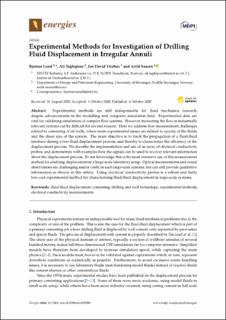| dc.contributor.author | Lund, Bjørnar | |
| dc.contributor.author | Taghipour, Ali | |
| dc.contributor.author | Ytrehus, Jan David | |
| dc.contributor.author | Saasen, Arild | |
| dc.date.accessioned | 2020-10-26T11:53:02Z | |
| dc.date.available | 2020-10-26T11:53:02Z | |
| dc.date.created | 2020-10-12T14:25:48Z | |
| dc.date.issued | 2020 | |
| dc.identifier.issn | 1996-1073 | |
| dc.identifier.uri | https://hdl.handle.net/11250/2684995 | |
| dc.description.abstract | Experimental methods are still indispensable for fluid mechanics research, despite advancements in the modelling and computer simulation field. Experimental data are vital for validating simulations of complex flow systems. However, measuring the flow in industrially relevant systems can be difficult for several reasons. Here we address flow measurement challenges related to cementing of oil wells, where main experimental issues are related to opacity of the fluids and the sheer size of the system. The main objective is to track the propagation of a fluid-fluid interface during a two-fluid displacement process, and thereby to characterize the efficiency of the displacement process. We describe the implementation and use of an array of electrical conductivity probes, and demonstrate with examples how the signals can be used to recover relevant information about the displacement process. To our knowledge this is the most extensive use of this measurement method for studying displacement in a large-scale laboratory setup. Optical measurements and visual observations are challenging and/or costly in such large-scale systems, but can still provide qualitative information as shown in this article. Using electrical conductivity probes is a robust and fairly low-cost experimental method for characterizing fluid-fluid displacement in large-scale systems. | en_US |
| dc.language.iso | eng | en_US |
| dc.publisher | MDPI | en_US |
| dc.rights | Navngivelse 4.0 Internasjonal | * |
| dc.rights.uri | http://creativecommons.org/licenses/by/4.0/deed.no | * |
| dc.subject | Cementing technique | en_US |
| dc.subject | Cementing technique | en_US |
| dc.subject | electrical conductivity measurements | en_US |
| dc.subject | experimental methods | en_US |
| dc.subject | drilling and well technology | en_US |
| dc.subject | cementing | en_US |
| dc.subject | fluid-fluid displacement | en_US |
| dc.title | Experimental Methods for Investigation of Drilling Fluid Displacement in Irregular Annuli | en_US |
| dc.type | Peer reviewed | en_US |
| dc.type | Journal article | en_US |
| dc.description.version | publishedVersion | en_US |
| dc.rights.holder | © 2020 by the authors. Licensee MDPI, Basel, Switzerland. This article is an open access article distributed under the terms and conditions of the Creative Commons Attribution (CC BY) license (http://creativecommons.org/licenses/by/4.0/). | en_US |
| dc.subject.nsi | VDP::Petroleumsteknologi: 512 | en_US |
| dc.subject.nsi | VDP::Petroleum engineering: 512 | en_US |
| dc.source.pagenumber | 25 | en_US |
| dc.source.volume | 13 | en_US |
| dc.source.journal | Energies | en_US |
| dc.source.issue | 19 | en_US |
| dc.identifier.doi | https://doi.org/10.3390/en13195201 | |
| dc.identifier.cristin | 1838900 | |
| dc.source.articlenumber | 5201 | en_US |
| cristin.ispublished | true | |
| cristin.fulltext | original | |
| cristin.qualitycode | 1 | |

